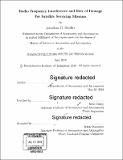Radio frequency interference and risk of damage for satellite servicing missions
Author(s)
Schiller, Jonathan D.(Jonathan David)
Download1119733194-MIT.pdf (14.14Mb)
Other Contributors
Massachusetts Institute of Technology. Department of Aeronautics and Astronautics.
Advisor
Kerri Cahoy.
Terms of use
Metadata
Show full item recordAbstract
This thesis assesses the potential for radiation transmitted from a servicing satellite in geostationary orbit to couple into the receivers on its intended client, thereby causing interference or even damage to receiver components. It begins by examining the satellite servicing paradigm, and introducing as case studies two missions that are currently in development. Then the theory of coupling is presented, starting with an overview of antennas, working toward the Friis transmission formula, and adapting it to be valid in the near-field. The analysis tools used are described, including TICRA GRASP, antenna modeling software used to apply the theory to this specific case. In GRASP, models of two servicing satellites representing Northrop Grumman's Mission Extension Vehicle (MEV) and DARPA's Robotic Servicing of Geosynchronous Satellites (RSGS) programs are created, as well as a model of a generic communications satellite to serve as their client. Two different communications systems are examined, with one using Ku-band and the other using both Ku-band and C-band, to see how much energy they couple into the client. The coupling is calculated over a range of distances and angles to investigate how these and other factors affected the levels seen by the receivers. Finally, the received levels are compared with the typical environment levels of radiation expected to be seen at geostationary orbit and with the specifications of typical hardware components to determine if signal reception would be affected and if the components were being exposed to higher input power than they were rated for. This analysis finds that during proximity operations, coupling can often rise above levels that would interfere with client operations and potentially damage some components, most critically the Low Noise Amplifier. In most cases, these risks occur when the servicer is closer than 100 m and directly above or below the client, and one satellite is therefore in the main transmit beam of the other. However, depending on the architecture of the receiver, it could have proper filters in place that would attenuate coupling from a servicer down to acceptable levels. The thesis ends with a list of recommendations for actions that can be taken by servicing satellite operators and future satellite manufacturers to reduce the effects of unwanted coupling during servicing operations.
Description
Thesis: S.M., Massachusetts Institute of Technology, Department of Aeronautics and Astronautics, 2019 Cataloged from PDF version of thesis. Includes bibliographical references (pages 109-110).
Date issued
2019Department
Massachusetts Institute of Technology. Department of Aeronautics and AstronauticsPublisher
Massachusetts Institute of Technology
Keywords
Aeronautics and Astronautics.